Numerical Simulation of Soil Water–Salt Dynamics and Agricultural Production in Reclaiming Coastal Areas Using Subsurface Pipe Drainage
Abstract
:1. Introduction
2. Materials and Methods
2.1. Experimental Site Description and Data Collection
2.2. Model Description
2.2.1. HYDRUS Model
2.2.2. AquaCrop Model
2.3. Model Evaluation Criterion
2.4. Simulation Scenarios
3. Results and Discussion
3.1. Model Performance Evaluation
3.1.1. HYDRUS Model Calibration and Validation
3.1.2. AquaCrop Model Calibration and Validation
3.2. Scenario Evaluation and Analysis
3.2.1. Response of Drainage Performance to Groundwater Salinity
3.2.2. Response of Crop Yield, Water Productivity, and Groundwater Supply to Different Scenarios
4. Conclusions
Author Contributions
Funding
Data Availability Statement
Acknowledgments
Conflicts of Interest
References
- Schuerch, M.; Spencer, T.; Temmerman, S.; Kirwan, M.L.; Wolff, C.; Lincke, D.; McOwen, C.J.; Pickering, M.D.; Reef, R.; Vafeidis, A.T.; et al. Future response of global coastal wetlands to sea-level rise. Nature 2018, 561, 231–234. [Google Scholar] [CrossRef] [Green Version]
- Wu, W.T.; Yang, Z.Q.; Tian, B.; Huang, Y.; Zhou, Y.X.; Zhang, T. Impacts of coastal reclamation on wetlands: Loss, resilience, and sustainable management. Estuar. Coast. Shelf Sci. 2018, 210, 153–161. [Google Scholar] [CrossRef]
- Robinson, C.E.; Xin, P.; Santos, I.R.; Charette, M.A.; Li, L.; Barry, D.A. Groundwater dynamics in subterranean estuaries of coastal unconfined aquifers: Controls on submarine groundwater discharge and chemical inputs to the ocean. Adv. Water Resour. 2018, 115, 315–331. [Google Scholar] [CrossRef]
- Zhan, L.C.; Xin, P.; Chen, J.S. Subsurface salinity distribution and evolution in low-permeability coastal areas after land reclamation: Field investigation. J. Hydrol. 2022, 612, 128250. [Google Scholar] [CrossRef]
- Long, X.H.; Liu, L.P.; Shao, T.Y.; Shao, H.B.; Liu, Z.P. Developing and sustainably utilize the coastal mudflat areas in China. Sci. Total Environ. 2016, 569, 1077–1086. [Google Scholar] [CrossRef]
- Iost, S.; Landgraf, D.; Makeschin, F. Chemical soil properties of reclaimed marsh soil from Zhejiang Province PR China. Geoderma 2007, 142, 245–250. [Google Scholar] [CrossRef]
- Velmurugan, A.; Swarnam, T.P.; Lal, R. Effect of land shaping on soil properties and crop yield in tsunami inundated coastal soils of Southern Andaman Island. Agric. Ecosyst. Environ. 2015, 206, 1–9. [Google Scholar] [CrossRef]
- Setiawan, I.; Morgan, L.; Doscher, C.; Ng, K.; Bosserelle, A. Mapping shallow groundwater salinity in a coastal urban setting to assess exposure of municipal assets. J. Hydrol. Reg. Stud. 2022, 40, 100999. [Google Scholar] [CrossRef]
- Forkutsa, I.; Sommer, R.; Shirokova, Y.I.; Lamers, J.P.A.; Kienzler, K.; Tischbein, B.; Martius, C.; Vlek, P.L.G. Modeling irrigated cotton with shallow groundwater in the Aral Sea Basin of Uzbekistan: I. Water dynamics. Irrig. Sci. 2009, 27, 331–346. [Google Scholar] [CrossRef]
- Islam, M.N.; Bell, R.W.; Barrett-Lennard, E.G.; Maniruzzaman, M.J.A.f.S.D. Shallow surface and subsurface drains alleviate waterlogging and salinity in a clay-textured soil and improve the yield of sunflower in the Ganges Delta. Agron. Sustain. Dev. 2022, 42, 16. [Google Scholar] [CrossRef]
- Fang, D.; Guo, K.; Ameen, A.; Wang, S.C.; Xie, J.; Liu, J.T.; Han, L.P. A Root Density Tradeoff in an Okra-Assisted Subsurface Pipe Drainage System for Amelioration of Saline Soil. Agronomy 2022, 12, 866. [Google Scholar] [CrossRef]
- Sloan, B.P.; Basu, N.B.; Mantilla, R. Hydrologic impacts of subsurface drainage at the field scale: Climate, landscape and anthropogenic controls. Agric. Water Manag. 2016, 165, 1–10. [Google Scholar] [CrossRef]
- Wang, Z.H.; Heng, T.; Li, W.H.; Zhang, J.Z.; Zhangzhong, L.L. Effects of subsurface pipe drainage on soil salinity in saline-sodic soil under mulched drip irrigation. Irrig. Drain. 2020, 69, 95–106. [Google Scholar] [CrossRef]
- Nozari, H.; Azadi, S.; Zali, A. Experimental study of the temporal variation of drain water salinity at different drain depths and spacing in the presence of saline groundwater. Sustain. Water Resour. Manag. 2018, 4, 887–895. [Google Scholar] [CrossRef]
- Shao, X.H.; Chang, T.T.; Cai, F.; Wang, Z.Y.; Huang, M.Y. Effects of subsurface drainage design on soil desalination in coastal resort of China. J. Food Agric. Environ. 2012, 10, 935–938. [Google Scholar]
- Tuohy, P.; O’Loughlin, J.; Fenton, O. Modeling performance of a tile drainage system incorporating mole drainage. Trans. Asabe 2018, 61, 169–178. [Google Scholar] [CrossRef] [Green Version]
- Bonaiti, G.; Borin, M. Efficiency of controlled drainage and subirrigation in reducing nitrogen losses from agricultural fields. Agric. Water Manag. 2010, 98, 343–352. [Google Scholar] [CrossRef]
- Ebrahimian, H.; Noory, H. Modeling paddy field subsurface drainage using HYDRUS-2D. Paddy Water Environ. 2015, 13, 477–485. [Google Scholar] [CrossRef]
- Lu, P.R.; Zhang, Z.Y.; Sheng, Z.; Huang, M.Y.; Zhang, Z.M. Assess Effectiveness of Salt Removal by a Subsurface Drainage with Bundled Crop Straws in Coastal Saline Soil Using HYDRUS-3D. Water 2019, 11, 943. [Google Scholar] [CrossRef] [Green Version]
- Tao, Y.; Li, N.; Wang, S.L.; Chen, H.R.; Guan, X.Y.; Ji, M.Z. Simulation study on performance of nitrogen loss of an improved subsurface drainage system for one-time drainage using HYDRUS-2D. Agric. Water Manag. 2021, 246, 106698. [Google Scholar] [CrossRef]
- Krevh, V.; Filipovic, V.; Filipovic, L.; Matekovic, V.; Petosic, D.; Mustac, I.; Ondrasek, G.; Bogunovic, I.; Kovac, Z.; Pereira, P.; et al. Modeling seasonal soil moisture dynamics in gley soils in relation to groundwater table oscillations in eastern Croatia. Catena 2022, 211, 105987. [Google Scholar] [CrossRef]
- Feddes, R.A. Simulation of field water use and crop yield. Soil Sci. 1978, 129, 193. [Google Scholar]
- Simunek, J.; Hopmans, J.W. Modeling compensated root water and nutrient uptake. Ecol. Model. 2009, 220, 505–521. [Google Scholar] [CrossRef]
- Ranjbar, A.; Rahimikhoob, A.; Ebrahimian, H.; Varavipour, M. Simulation of nitrogen uptake and dry matter for estimation of nitrogen nutrition index during the maize growth period. J. Plant Nutr. 2022, 45, 920–936. [Google Scholar] [CrossRef]
- Zhou, J.; Cheng, G.D.; Li, X.; Hu, B.X.; Wang, G.X. Numerical Modeling of Wheat Irrigation using Coupled HYDRUS and WOFOST Models. Soil Sci. Soc. Am. J. 2012, 76, 648–662. [Google Scholar] [CrossRef]
- Roy, P.C.; Guber, A.; Abouali, M.; Nejadhashemi, A.P.; Deb, K.; Smucker, A.J.M. Crop yield simulation optimization using precision irrigation and subsurface water retention technology. Environ. Model. Softw. 2019, 119, 433–444. [Google Scholar] [CrossRef]
- Zhao, J.; Han, T.; Wang, C.; Jia, H.; Worqlul, A.W.; Norelli, N.; Zeng, Z.H.; Chu, Q.Q. Optimizing irrigation strategies to synchronously improve the yield and water productivity of winter wheat under interannual precipitation variability in the North China Plain. Agric. Water Manag. 2020, 240, 106298. [Google Scholar] [CrossRef]
- Goosheh, M.; Pazira, E.; Gholami, A.; Andarzian, B.; Panahpour, E. Improving Irrigation Scheduling of Wheat to Increase Water Productivity in Shallow Groundwater Conditions Using Aquacrop. Irrig. Drain. 2018, 67, 738–754. [Google Scholar] [CrossRef]
- Zhang, C.; Xie, Z.A.; Wang, Q.J.; Tang, M.; Feng, S.Y.; Cai, H.J. AquaCrop modeling to explore optimal irrigation of winter wheat for improving grain yield and water productivity. Agric. Water Manag. 2022, 266, 107580. [Google Scholar] [CrossRef]
- Hammami, Z.; Qureshi, A.S.; Sahli, A.; Gauffreteau, A.; Chamekh, Z.; Ben Azaiez, F.E.; Ayadi, S.; Trifa, Y. Modeling the Effects of Irrigation Water Salinity on Growth, Yield and Water Productivity of Barley in Three Contrasted Environments. Agronomy 2020, 10, 1459. [Google Scholar] [CrossRef]
- Hsiao, T.C.; Heng, L.; Steduto, P.; Rojas-Lara, B.; Raes, D.; Fereres, E. AquaCrop-The FAO Crop Model to Simulate Yield Response to Water: III. Parameterization and Testing for Maize. Agron. J. 2009, 101, 448–459. [Google Scholar] [CrossRef]
- Akhtar, F.; Tischbein, B.; Awan, U.K. Optimizing Deficit Irrigation Scheduling Under Shallow Groundwater Conditions in Lower Reaches of Amu Darya River Basin. Water Resour. Manag. 2013, 27, 3165–3178. [Google Scholar] [CrossRef]
- Tenreiro, T.R.; Jerabek, J.; Gomez, J.A.; Zumr, D.; Martinez, G.; Garcia-Vila, M.; Fereres, E. Simulating water lateral inflow and its contribution to spatial variations of rainfed wheat yields. Eur. J. Agron. 2022, 137, 126515. [Google Scholar] [CrossRef]
- Shirokova, Y.; Forkutsa, I.; Sharafutdinova, N. Use of Electrical Conductivity Instead of Soluble Salts for Soil Salinity Monitoring in Central Asia. Irrig. Drain. Syst. 2000, 14, 199–205. [Google Scholar] [CrossRef]
- Patrignani, A.; Ochsner, T.E. Canopeo: A Powerful New Tool for Measuring Fractional Green Canopy Cover. Agron. J. 2015, 107, 2312–2320. [Google Scholar] [CrossRef] [Green Version]
- Razzaghi, F.; Zhou, Z.J.; Andersen, M.N.; Plauborg, F. Simulation of potato yield in temperate condition by the AquaCrop model. Agric. Water Manag. 2017, 191, 113–123. [Google Scholar] [CrossRef]
- Abbasi, F.; Simunek, J.; Feyen, J.; van Genuchten, M.T.; Shouse, P.J. Simultaneous inverse estimation of soil hydraulic and solute transport parameters from transient field experiments: Homogeneous soil. Trans. ASAE 2003, 46, 1085–1095. [Google Scholar] [CrossRef] [Green Version]
- Mualem, Y. A new model for predicting the hydraulic conductivity of unsaturated porous media. Water Resour. Res. 1976, 12, 513–522. [Google Scholar] [CrossRef] [Green Version]
- Genuchten, M.T.v. A Closed-form Equation for Predicting the Hydraulic Conductivity of Unsaturated Soils. Soil Sci. Soc. Am. J. 1980, 44, 892–898. [Google Scholar] [CrossRef] [Green Version]
- Allen, R.G.; Pereira, L.S.; Raes, D.; Smith, M. Crop Evapotranspiration—Guidelines for Computing Crop Water Requirements; Food and Agriculture Organization of the United Nations (FAO): Rome, Italy, 1998. [Google Scholar]
- Zhu, Y.H.; Ren, L.L.; Horton, R.; Lu, H.S.; Wang, Z.L.; Yuan, F. Estimating the Contribution of Groundwater to the Root Zone of Winter Wheat Using Root Density Distribution Functions. Vadose Zone J. 2018, 17, 1–15. [Google Scholar] [CrossRef] [Green Version]
- Nielsen, D.C.; Miceli-Garcia, J.J.; Lyon, D.J. Canopy Cover and Leaf Area Index Relationships for Wheat, Triticale, and Corn. Agron. J. 2012, 104, 1569–1573. [Google Scholar] [CrossRef] [Green Version]
- Vrugt, J.A.; van Wijk, M.T.; Hopmans, J.W.; Simunek, J. One-, two-, and three-dimensional root water uptake functions for transient modeling. Water Resour. Res. 2001, 37, 2457–2470. [Google Scholar] [CrossRef] [Green Version]
- Schaap, M.G.; Leij, F.J.; van Genuchten, M.T. ROSETTA: A computer program for estimating soil hydraulic parameters with hierarchical pedotransfer functions. J. Hydrol. 2001, 251, 163–176. [Google Scholar] [CrossRef]
- Ramos, T.B.; Simunek, J.; Goncalves, M.C.; Martins, J.C.; Prazeres, A.; Pereira, L.S. Two-dimensional modeling of water and nitrogen fate from sweet sorghum irrigated with fresh and blended saline waters. Agric. Water Manag. 2012, 111, 87–104. [Google Scholar] [CrossRef]
- Radcliffe, D.E.; Šimůnek, J. Soil Physics with HYDRUS; CRC Press: Boca Raton, FL, USA; Taylor &Francis Group: Abingdon, UK, 2010. [Google Scholar]
- Skaggs, T.H.; Shouse, P.J.; Poss, J.A. Irrigating forage crops with saline waters: 2. Modeling root uptake and drainage. Vadose Zone J. 2006, 5, 824–837. [Google Scholar] [CrossRef]
- Karandish, F.; Simunek, J. An application of the water footprint assessment to optimize production of crops irrigated with saline water: A scenario assessment with HYDRUS. Agric. Water Manag. 2018, 208, 67–82. [Google Scholar] [CrossRef] [Green Version]
- Grattan, S. Irrigation Water Salinity and Crop Production; UCANR Publications: Oakland, CA, USA, 2002; Volume 9. [Google Scholar]
- Mondal, M.S.; Saleh, A.F.M.; Akanda, M.A.R.; Biswas, S.K.; Moslehuddin, A.Z.M.; Zaman, S.; Lazar, A.N.; Clarke, D. Simulating yield response of rice to salinity stress with the AquaCrop model. Environ. Sci. -Process. Impacts 2015, 17, 1118–1126. [Google Scholar] [CrossRef] [Green Version]
- Foster, T.; Brozovic, N.; Butler, A.P.; Neale, C.M.U.; Raes, D.; Steduto, P.; Fereres, E.; Hsiao, T.C. AquaCrop-OS: An open source version of FAO’s crop water productivity model. Agric. Water Manag. 2017, 181, 18–22. [Google Scholar] [CrossRef]
- Saab, M.T.A.; Todorovic, M.; Albrizio, R. Comparing Aqua Crop and CropSyst models in simulating barley growth and yield under different water and nitrogen regimes. Does calibration year influence the performance of crop growth models? Agric. Water Manag. 2015, 147, 21–33. [Google Scholar] [CrossRef]
- Raes, D.; Steduto, P.; Hsiao, T.C.; Fereres, E. AquaCrop-The FAO Crop Model to Simulate Yield Response to Water: II. Main Algorithms and Software Description. Agron. J. 2009, 101, 438–447. [Google Scholar] [CrossRef] [Green Version]
- Pourgholam-Amiji, M.; Liaghat, A.; Ghameshlou, A.N.; Khoshravesh, M. The evaluation of DRAINMOD-S and AquaCrop models for simulating the salt concentration in soil profiles in areas with a saline and shallow water table. J. Hydrol. 2021, 598, 126259. [Google Scholar] [CrossRef]
- Davarpanah, R.; Ahmadi, S.H. Modeling the effects of irrigation management scenarios on winter wheat yield and water use indicators in response to climate variations and water delivery systems. J. Hydrol. 2021, 598, 126269. [Google Scholar] [CrossRef]
- Montoya, F.; Camargo, D.; Ortega, J.F.; Corcoles, J.I.; Dominguez, A. Evaluation of Aquacrop model for a potato crop under different irrigation conditions. Agric. Water Manag. 2016, 164, 267–280. [Google Scholar] [CrossRef]
- Kumar, M.; Sarangi, A.; Singh, D.K.; Rao, A.R. Modelling the Grain Yield of Wheat in Irrigated Saline Environment with Foliar Potassium Fertilization. Agric. Res. 2018, 7, 321–337. [Google Scholar] [CrossRef]
- Xu, J.Z.; Bai, W.H.; Li, Y.W.; Wang, H.Y.; Yang, S.H.; Wei, Z. Modeling rice development and field water balance using AquaCrop model under drying-wetting cycle condition in eastern China. Agric. Water Manag. 2019, 213, 289–297. [Google Scholar] [CrossRef]
- Qian, Y.Z.; Zhu, Y.; Ye, M.; Huang, J.S.; Wu, J.W. Experiment and numerical simulation for designing layout parameters of subsurface drainage pipes in arid agricultural areas. Agric. Water Manag. 2021, 243, 106455. [Google Scholar] [CrossRef]
- Tao, Y.; Wang, S.L.; Xu, D.; Guan, X.Y.; Ji, M.Z.; Liu, J. Theoretical analysis and experimental verification of the improved subsurface drainage discharge with ponded water. Agric. Water Manag. 2019, 213, 546–553. [Google Scholar] [CrossRef]
- Chow, V.T.; Maidment, D.R.; Mays, L.W. Handbook of Applied Hydrology; McGraw-Hill: New York, NY, USA, 1988. [Google Scholar]
- Liu, Y.; Ao, C.; Zeng, W.; Kumar Srivastava, A.; Gaiser, T.; Wu, J.; Huang, J. Simulating water and salt transport in subsurface pipe drainage systems with HYDRUS-2D. J. Hydrol. 2021, 592, 125823. [Google Scholar] [CrossRef]
- Sandhu, R.; Irmak, S. Assessment of AquaCrop model in simulating maize canopy cover, soil-water, evapotranspiration, yield, and water productivity for different planting dates and densities under irrigated and rainfed conditions. Agric. Water Manag. 2019, 224, 105753. [Google Scholar] [CrossRef]
- Huang, M.; Wang, C.; Qi, W.; Zhang, Z.; Xu, H. Modelling the integrated strategies of deficit irrigation, nitrogen fertilization, and biochar addition for winter wheat by AquaCrop based on a two-year field study. Field Crops Res. 2022, 282, 108510. [Google Scholar] [CrossRef]
- Raes, D.; Steduto, P.; Hsiao, T.C.; Fereres, E. Reference Manual AquaCrop; FAO Land and Water Division: Rome, Italy, 2012. [Google Scholar]
- Song, Y.; Shen, Y.M.; Xie, R.F.; Li, J.L. A DSAS-based study of central shoreline change in Jiangsu over 45 years. Anthr. Coasts 2021, 4, 115–128. [Google Scholar] [CrossRef]
- Shang, T.X.; Xu, Z.W.; Gong, X.L.; Li, X.Q.; Tian, S.B.; Guan, Y.X. Application of electrical sounding to determine the spatial distribution of groundwater quality in the coastal area of Jiangsu Province, China. J. Hydrol. 2021, 599, 126348. [Google Scholar] [CrossRef]
- Zhang, K.; Shao, G.C.; Wang, Z.Y.; Cui, J.T.; Lu, J.; Gao, Y. Modeling the impacts of groundwater depth and biochar addition on tomato production under climate change using RZWQM2. Sci. Hortic. 2022, 302, 111147. [Google Scholar] [CrossRef]
- Aissa, I.B.; Bouarfa, S.; Vincent, B.; Chaumont, C.; Perrier, A. Drainage performance assessment in a modernized oasis system. Irrig. Drain. 2013, 62, 221–228. [Google Scholar] [CrossRef]
- Gao, X.Y.; Bai, Y.N.; Huo, Z.L.; Xu, X.; Huang, G.H.; Xia, Y.H.; Steenhuis, T.S. Deficit irrigation enhances contribution of shallow groundwater to crop water consumption in arid area. Agric. Water Manag. 2017, 185, 116–125. [Google Scholar] [CrossRef]
- Li, H.J.; Yi, J.; Zhang, J.G.; Zhao, Y.; Si, B.C.; Hill, R.L.; Cui, L.L.; Liu, X.Y. Modeling of Soil Water and Salt Dynamics and Its Effects on Root Water Uptake in Heihe Arid Wetland, Gansu, China. Water 2015, 7, 2382–2401. [Google Scholar] [CrossRef] [Green Version]

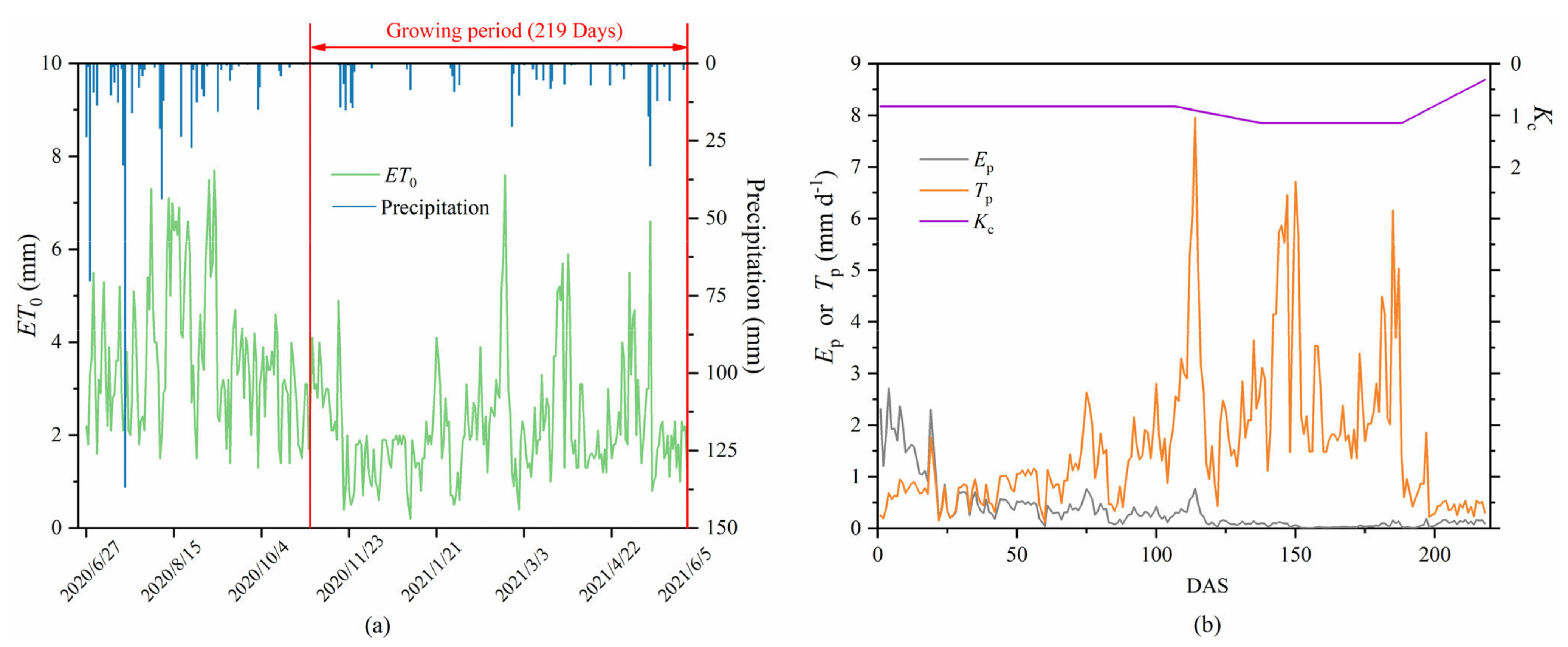

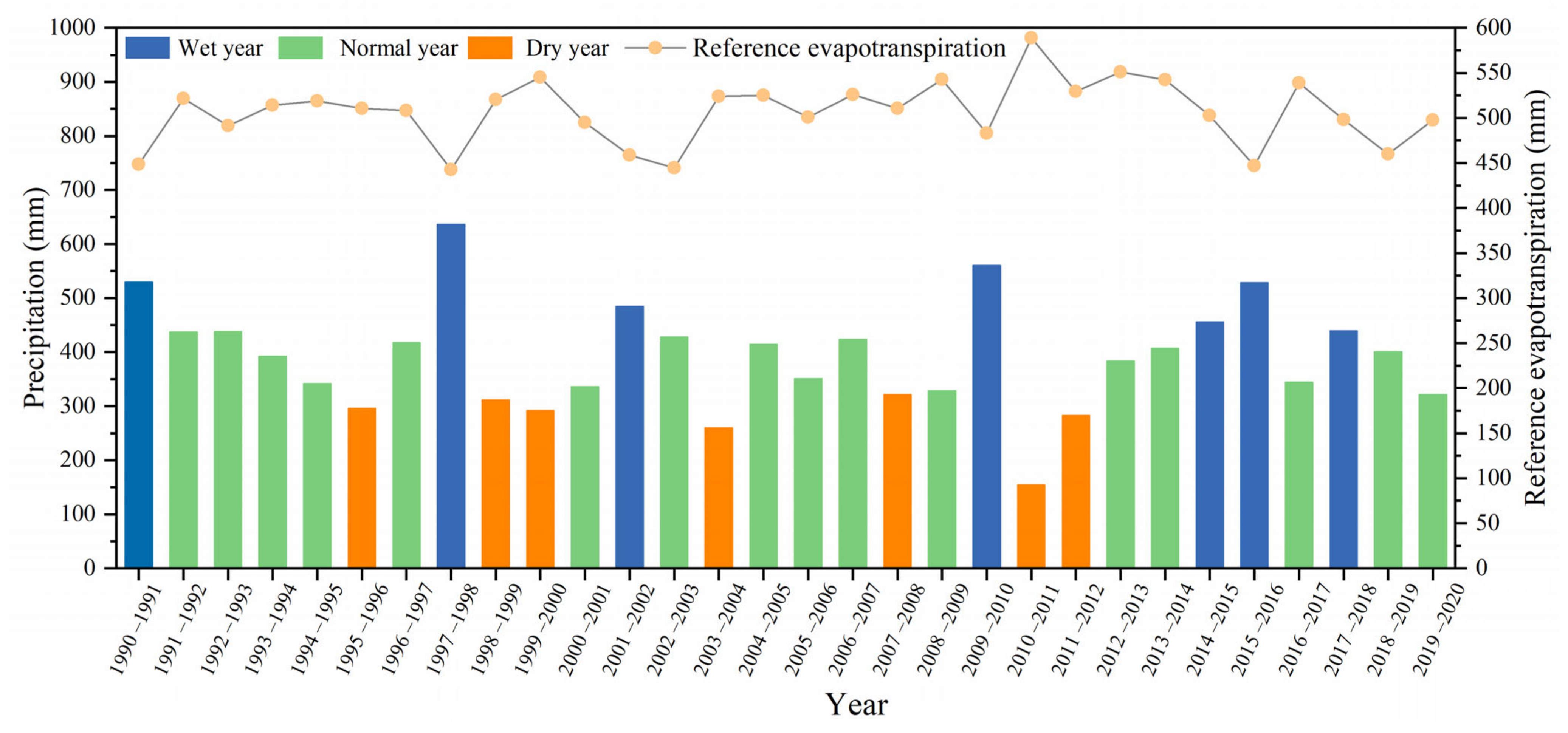
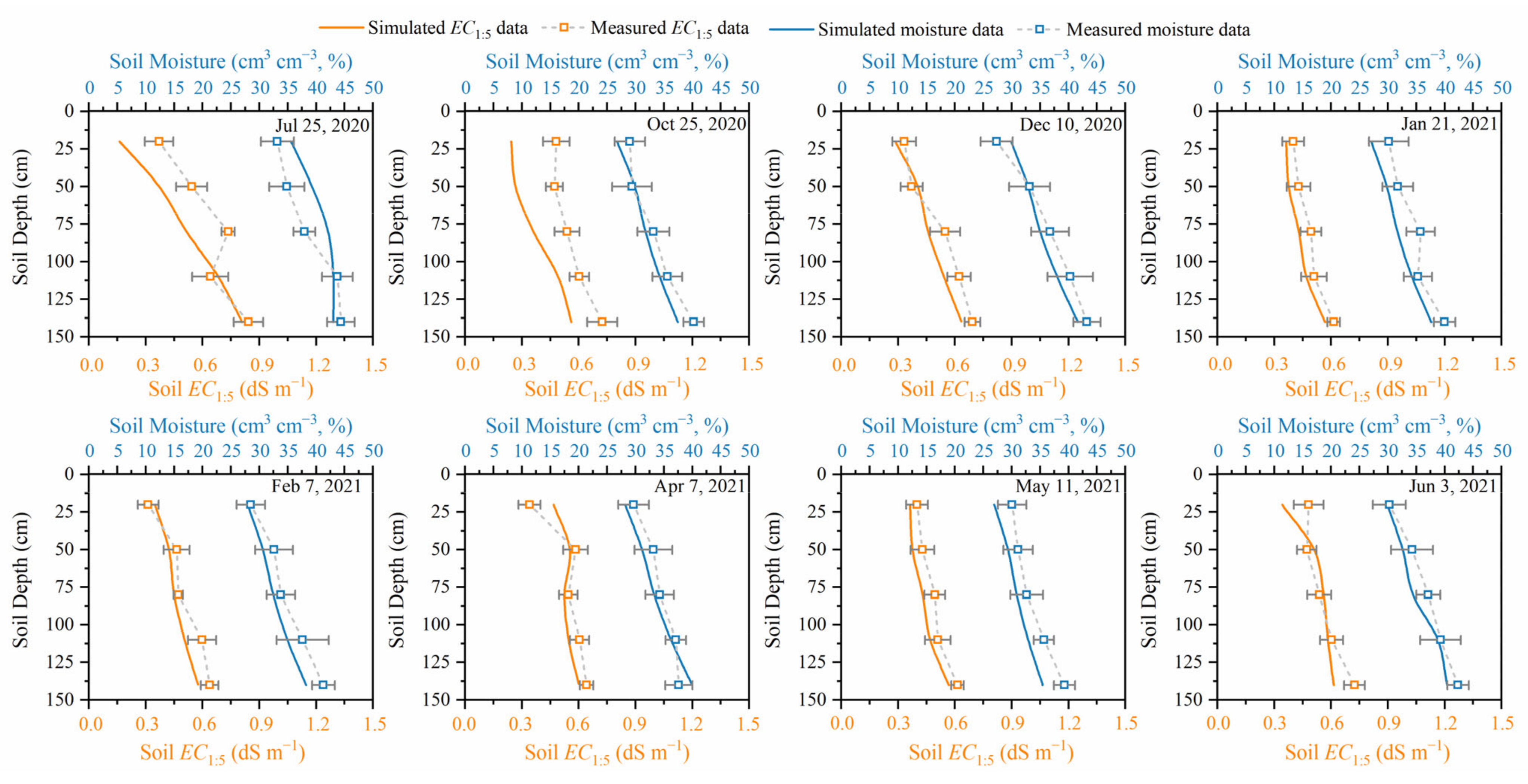
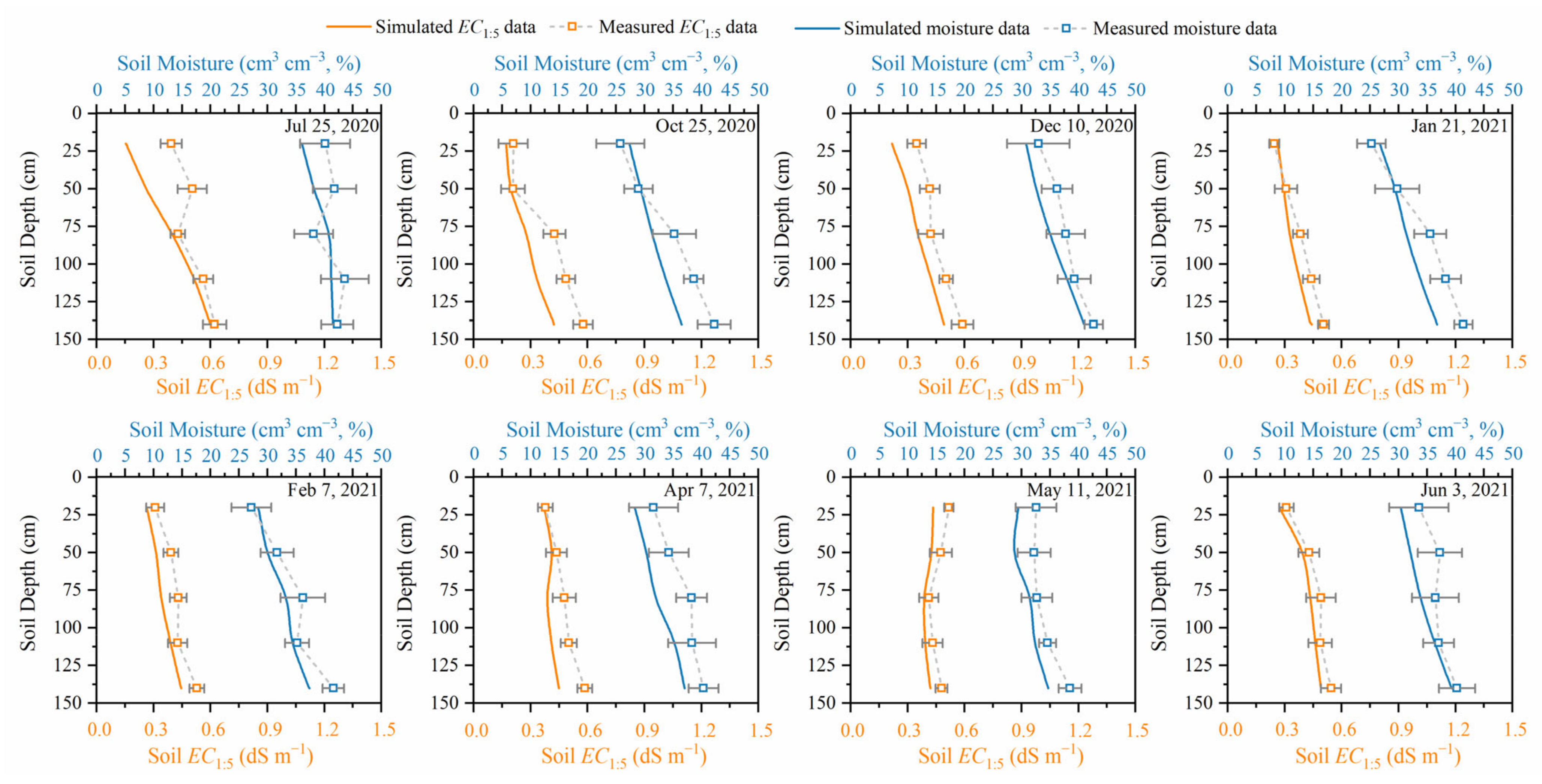
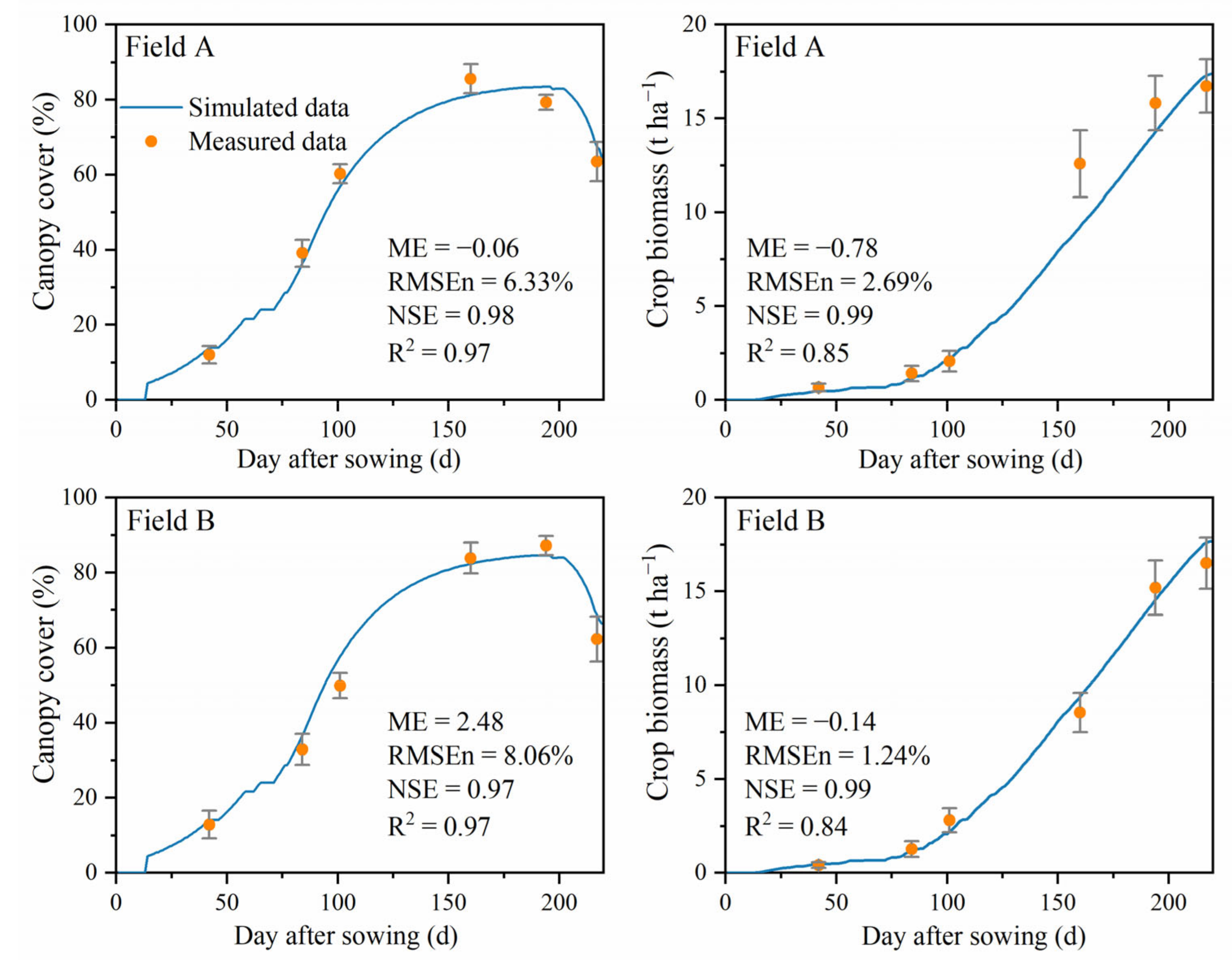



| Depth (cm) | Bulk Density (g cm−3) | Field Capacity (cm3 cm−3) | Wilting Point (cm−3 cm−3) | Saturated Water Content (cm−3 cm−3) | Mechanical Composition (%) | Soil Texture | ||
|---|---|---|---|---|---|---|---|---|
| Sand | Slit | Clay | ||||||
| 0–30 | 1.36 a | 0.22 a | 0.12 a | 0.46 b | 40.9 | 56.3 | 2.8 | Silt loam |
| 30–100 | 1.42 b | 0.29 b | 0.14 a | 0.42 a | 35.4 | 61.3 | 3.3 | |
| 100–200 | 1.44 b | 0.31 b | 0.15 a | 0.42 a | 35.5 | 60.4 | 4.1 | |
| 200–300 | 1.45 b | 0.32 b | 0.15 a | 0.41 a | 33.9 | 62.2 | 3.9 | |
| Soil Layer (cm) | θr (cm3 cm−3) | θs (cm3 cm−3) | α | n | l | Ks (cm day−1) |
|---|---|---|---|---|---|---|
| 0~30 cm | 0.037 | 0.463 | 0.019 | 1.419 | 0.5 | 105.31 |
| 30~300 cm | 0.041 | 0.415 | 0.013 | 1.453 | 0.5 | 58.52 |
| Parameter Description | Value | Status |
|---|---|---|
| Non-conservative parameters | ||
| Sowing rate | 250 kg seed hm−2 | M |
| Cover per seeding | 1.5 cm2 plant | M |
| Initial canopy cover | 5.2% | M |
| Canopy growth coefficient | 3.2% day−1 | C |
| Canopy decline coefficient | 6.9% day−1 | C |
| Maximum canopy cover | 93% | C |
| Time from sowing to emergence | 12 day | M |
| Time from sowing to max canopy | 175 day | M |
| Time from sowing to senescence | 197 day | M |
| Time from sowing to maturity | 219 day | M |
| Time from sowing to flowing | 181 day | M |
| Minimum effective rooting depth | 0.3 m | C |
| Maximum effective rooting depth | 1.15 | C |
| Time from sowing to maximum rooting depth | 90 day | C |
| Sharp factor describing root zone expansion | 1.5 | D |
| Reference harvest index | 41% | C |
| Minimum temperature of pollination fail | 5 °C | D |
| Maximum temperature of pollination fail | 35 °C | D |
| Salinity stress, lower thresholds | 6 dS m−1 | D |
| Salinity stress, upper thresholds | 20 dS m−1 | D |
| Conservative parameters | ||
| Base temperature | 0 °C | D |
| Upper temperature | 26 °C | D |
| Canopy cover per seeding | 1.5 cm2 Plant−1 | D |
| Normalized crop water productivity | 15 g m−2 | D |
| Canopy expansion, upper threshold | 0.2% | D |
| Canopy expansion, lower threshold | 0.65% | D |
| Stomatal conductance threshold | 0.65% | D |
| Stomata stress coefficient curve shape | 2.5 | D |
| Senescence stress upper threshold | 0.7% | D |
| Senescence stress coefficient curve shape | 2.5 | D |
| Stage | Data Series | ME | RMSEn | NSE | R2 |
|---|---|---|---|---|---|
| Calibration | Moisture (cm3 cm−3) | −1.611 | 7.72% | 0.749 | 0.822 |
| Salt content (dS m−1) | −0.058 | 18.63% | 0.677 | 0.764 | |
| Validation | Moisture (cm3 cm−3) | −3.452 | 11.71% | 0.595 | 0.778 |
| Salt content (dS m−1) | −0.098 | 29.30% | 0.434 | 0.690 |
Disclaimer/Publisher’s Note: The statements, opinions and data contained in all publications are solely those of the individual author(s) and contributor(s) and not of MDPI and/or the editor(s). MDPI and/or the editor(s) disclaim responsibility for any injury to people or property resulting from any ideas, methods, instructions or products referred to in the content. |
© 2023 by the authors. Licensee MDPI, Basel, Switzerland. This article is an open access article distributed under the terms and conditions of the Creative Commons Attribution (CC BY) license (https://creativecommons.org/licenses/by/4.0/).
Share and Cite
Lu, P.; Yang, Y.; Luo, W.; Zhang, Y.; Jia, Z. Numerical Simulation of Soil Water–Salt Dynamics and Agricultural Production in Reclaiming Coastal Areas Using Subsurface Pipe Drainage. Agronomy 2023, 13, 588. https://doi.org/10.3390/agronomy13020588
Lu P, Yang Y, Luo W, Zhang Y, Jia Z. Numerical Simulation of Soil Water–Salt Dynamics and Agricultural Production in Reclaiming Coastal Areas Using Subsurface Pipe Drainage. Agronomy. 2023; 13(2):588. https://doi.org/10.3390/agronomy13020588
Chicago/Turabian StyleLu, Peirong, Yujie Yang, Wan Luo, Yu Zhang, and Zhonghua Jia. 2023. "Numerical Simulation of Soil Water–Salt Dynamics and Agricultural Production in Reclaiming Coastal Areas Using Subsurface Pipe Drainage" Agronomy 13, no. 2: 588. https://doi.org/10.3390/agronomy13020588




